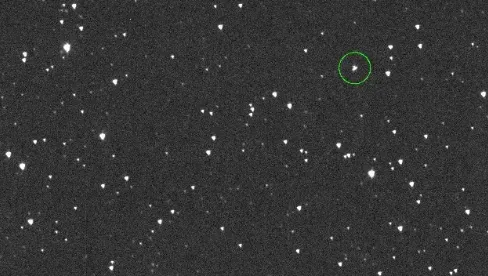
Astronomers have been keeping a close eye on an asteroid between 130 and 300 feet long that has a very small chance of crashing into Earth in less than eight years.
And as they learn more about asteroid 2024 YR4’s trajectory, the odds of impact are expected to slightly rise before falling (hopefully to zero), asteroid hunter David Rankin told Space.com.
That process has started to unfold since the asteroid was first spotted late last year on a potential collision course with Earth in 2032. For a time, the odds of impact fluctuated around 1% before suddenly jumping in recent days to 2.3%.
The unsettling odds are the highest any asteroid has had of impacting Earth in more than two decades since the infamous Apophis was first discovered and later ruled out as a threat. But astronomers still aren’t too concerned yet about YR4, and they insist that you shouldn’t be, either.
In the weeks, months and years ahead, space agencies around the world plan to monitor YR4 to better calculate a trajectory that more than likely will be harmless. And on the slim chance that the asteroid does indeed pose a threat, it may be time for Earth to implement its planetary defense strategies that agencies like NASA and the European Space Agency have spent years readying.
What to know about 2024 YR4:Scientists taking ‘active measures’ for asteroid with slight chance of hitting earth.
What is asteroid 2024 YR4 and why are scientists paying attention to it?
Asteroid 2024 YR4 has been a source of alarm because it carries an uncommonly high risk of colliding into Earth – an event that would be catastrophic, even if it wouldn’t cause a mass extinction.
The space rock was spotted late last year and reported on Dec. 27, 2024 to the Minor Planet Center, the official authority for observing and reporting new asteroids, comets and other small bodies in the solar system. The object eventually caught the attention of NASA and other astronomers when it rose on the U.S. Space Agency’s Sentry Impact Risk Table, which tracks any known asteroids with a non-zero probability of hitting Earth.
Initial projections gave the asteroid little more than a 1% chance of impacting Earth on Dec. 22, 2032. Asteroid 2024 YR4 also rated 3 of 10 on the Torino Impact Hazard Scale, a method for astronomers to categorize and rate the threat of near-Earth objects.
The International Asteroid Warning Network also put out a list of possible impact locations, which ranges from uninhabited or sparsely populated areas to densely populated areas in the eastern Pacific Ocean, northern South America, the Atlantic Ocean, parts of Africa, the Arabian Sea and South Asia.
What are the latest odds of YR4 hitting Earth?
As additional observations came in, the risk of asteroid 2024 YR4 hitting Earth went up. Last week, the impact probability stood at 2.3%, according to NASA.
The asteroid will continue to be visible from Earth through April, giving astronomers some time to gather data with ground-based telescopes. While the asteroid won’t again be observable from Earth until June 2028, NASA’s James Webb Space Telescope will be able to study it in March from orbit.
“As more observations of the asteroid’s orbit are obtained, its impact probability will become better known,” NASA said in a recent blog post. “It is possible that asteroid 2024 YR4 will be ruled out as an impact hazard, as has happened with many other objects.”
Among those objects is Apophis, the cruise ship-sized asteroid first discovered in 2004.
Asteroid 2024 YR4’s rating of 3 on the Torino Scale is the second-highest an asteroid has ever reached after the Apophis briefly hit a rating of 4. The risk of Apophis impacting Earth during its 2029 flyby even rose as high as 2.7% on the Sentry Impact Risk Table.
In the case of Apophis, further observations eventually allowed astronomers in 2021 to rule out the possibility of an impact when the asteroid makes a close flyby to Earth in 2029 and again in 2036.
NASA, other space agencies build planetary defense from asteroids
In the coming years, both NASA and the European Space Agency plan to take advantage of the rare flyby by sending uncrewed spacecraft to observe Apophis.
It’s one of the many plans the agencies have in place as part of a larger effort to build a defense to protect humanity from threats posed by asteroids and other inbound space rocks.
In September 2022, NASA demonstrated that it was possible to nudge an incoming asteroid out of harm’s way by slamming a spacecraft into it as part of its Double Asteroid Redirection Test, or DART.
Launched in November 2021, DART traveled for more than 10 months before crashing into Dimorphos at roughly 14,000 mph. Though the tiny asteroid posed no threat to Earth, NASA had set out to test a method of redirecting threatening objects hurtling toward Earth.
In October, a craft from the European Space Agency is on the way to get an up-close look at the asteroid’s remnants.
NASA is additionally working on an asteroid-hunting telescope known as the NEO Surveyor to find near-Earth objects capable of causing significant damage. Set to launch no earlier than June 2028, the telescope is designed to discover 90% of asteroids and comets that are 460 feet in size or larger and come within 30 million miles of Earth’s orbit.
Eric Lagatta covers breaking and trending news for USA TODAY. Reach him at [email protected]



